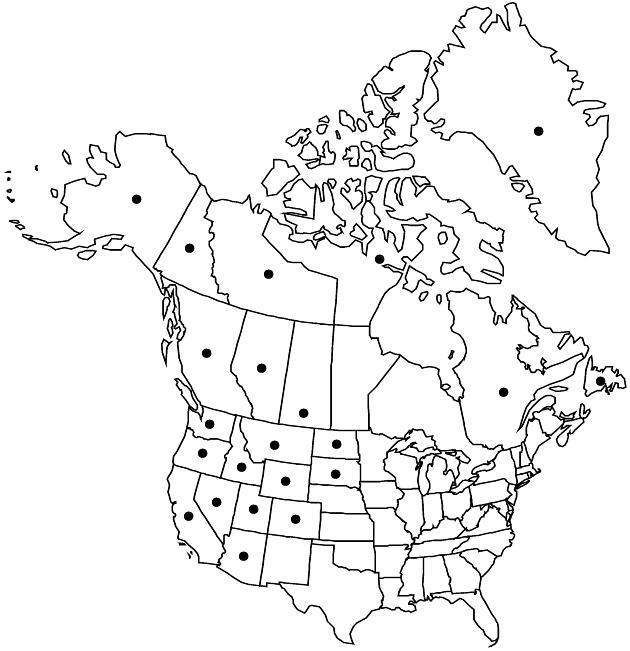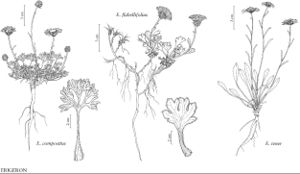Erigeron compositus
Fl. Amer. Sept. 2: 535. 1813.
Perennials, 5–15(–25 cm); taprooted, caudices simple or branches usually relatively thick and short, rarely slender and rhizomelike, covered with persistent leaf bases. Stems erect (simple, ± scapiform), sparsely hispido-pilose, minutely glandular. Leaves mostly basal (persistent); blades spatulate to obovate-spatulate, 5–50(–70) × (2–)4–12 mm, margins (1–)2–3(–4)-ternately lobed or dissected, cauline bractlike, mostly entire, faces densely hispiduloso-puberulent to glabrate, minutely glandular. Heads (sometimes disciform) 1. Involucres 5–10 × 8–20 mm. Phyllaries in 2–3 series (purple-tipped), hirsute (hairs spreading), minutely glandular. Ray (pistillate) florets 20–60; corollas white to pink or blue, usually 6–12 mm, often reduced to tubes (heads disciform), laminae not coiling or reflexing. Disc corollas 3–5 mm. Cypselae 1.6–2.7 mm, 2-nerved, faces sparsely strigose-hirsute; pappi: outer usually of setae, sometimes 0, inner of 12–20 bristles. 2n = 18, 36, 45, 54.
Phenology: Flowering (May–)Jun–Aug.
Habitat: Sagebrush, rabbitbrush, aspen to aspen-fir, subalpine meadows, cliffs, talus, and boulders
Elevation: (in e Canada, possibly Greenland and Arctic bridge gap, 10–200–)1800–4300 m
Distribution

Greenland, Alta., B.C., Nfld. and Labr. (Nfld.), N.W.T., Nunavut, Que., Sask., Yukon, Alaska, Ariz., Calif., Colo., Idaho, Mont., Nev., N.Dak., Oreg., S.Dak., Utah, Wash., Wyo., e Asia (Russian Far East).
Discussion
Correlations among ploidal level, breeding systems, and morphologic variation have been studied in detail in Erigeron compositus. Five informally designated population systems of diploids are geographically restricted (all of the northwestern United States and adjacent Canada) and primarily sexual, compared to the polyploids, which are agamospermous and apparently of hybrid origin, at least in some cases (R. D. Noyes et al. 1995; Noyes and D. E. Soltis 1996). Reduction in ray floret laminae usually is correlated with polyploidy. Plants with 1-ternately lobed leaves have been identified as var. glabratus, an element of variation that does not have a geographic pattern.
Among closely related species, Erigeron compositus is the only one that produces strongly thickened caudex branches; occasional collections show a tendency toward the slender, loose branches characteristic of the other species.
